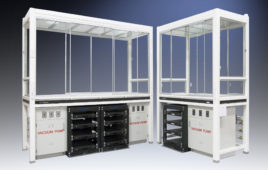Q: Can you offer any tips on how to recover when a disaster impacting manufacturing strikes, and what we should have/would have/could have done to plan for it?
A: “Plan for what is difficult.” Sun Tzu
Disasters happen, and they’re never opportune — despite that famous claim that “every cloud has a silver lining.”
Regardless of the cause — natural disaster, weather, accident, workplace violence, fire, terrorism, chemical spills or releases, catastrophic utility or IT failure — an organization’s recovery goals remain the same. The overarching objectives are to protect human lives and safety, while minimizing the impact to operations and revenue. All else is rooted in these goals, including limiting the extent of the disruption, minimizing negative hits to the company’s reputation (and stock price), restoring normal operations as quickly as possible, and minimizing confusion during an emergency. Manufacturing in a controlled environment adds another level of complexity to the challenge.
The first step in recovering from a disaster is to have planned for it — Sun Tzu could never have anticipated the potential pitfalls of modern cleanroom operations when he wrote The Art of War. Much of his advice remains cogent today, and is utilized by both members of the military and business. My former colleague, Richard Bilodeau, PE, wrote about developing a disaster recovery plan.1 Dick also wrote about the nuts and bolts of how to produce a disaster recovery plan.2 They’re oldies but goodies, with lots of practical information.
In this column, I’ll focus on selected key principles and important steps to take when your cleanroom facility is hit with a crisis of any sort.
Principle #1: People first.
If people have been hurt or killed in the incident, don’t disregard or fail to acknowledge that fact. Ensure they and their families are cared for as well as possible. Publicly acknowledge the role they played in the company, as well as their key attributes. Understand that people come before all else.
Principle #2: Stabilize the situation—focus on mitigation and restoring normal operating conditions.
During the heat of a crisis, one needs to stabilize the situation first, ensuring all danger has been neutralized. Only then can the team focus on mitigating any damage and restoring normal operations.
Principle #3: Communicate.
Get in front of the situation, and keep key constituencies informed on a regular basis. Always remember that the industry rumor mill is usually worse than reality, and in today’s 24/7 Internet-based world, rumors travel fast. Own the narrative, but be factual, transparent, and truthful — anything less will eventually bite you in the proverbial backside.
At the same time, not every detail is meant to be shared. Which groups should be kept informed is a call that needs to be made based on the circumstance: company management and employees (and their families); clients and customers; investors; suppliers; government officials at the local, state, federal, and international levels as warranted; and the media. Use all appropriate outlets, whether mainstream press or social media channels — and monitor the traffic that’s out there with an eye to correcting bad information in a non-combative, non-defensive way.
Have a single spokesperson, in a position appropriately aligned to the severity of the situation. There’s nothing worse than mixed messages, or self-designated spokespeople shooting from the hip. When selecting a spokesperson, make sure it’s someone who is unflappable, can recognize and understand “the question behind the question,” and can comprehend the potential business obligations and legal liabilities their answers may create.
Entire volumes have been written about crisis communications. Do yourself and your company a favor: be sure you have an expert staffer or consultant driving the response. Not everyone can drive this type of communications competently or well.
Principle #4: Keep a focus on getting operational, and use all your resources.
Depending on the cause of business interruption, you will likely need to reach outside the facilities group and marshal all hands to get the operations up and running in as short a time as possible. Key team members may come from operations, finance, procurement, legal, EH&S, security, sales, marketing, government relations, HR, and, as previously mentioned, corporate communications. Even your food services group may need to turn out to support the core team in a drawn-out situation.
Principle #5: Keep records.
Crises have a funny habit of turning into litigation. Keep scrupulous records of the situation, decisions made, rationale behind the decisions, the players and the timing of all mitigation actions, and changes in the disaster. Appoint some observers/scribes to your team, with one assigned exclusively to command with the sole responsibility to record the entire incident response. Use technology, including cameras and video, to accurately memorialize the situation.
Principle #6: Redundant systems, suppliers, and manufacturing capabilities are your best friends.
“For the want of a nail, the shoe was lost. For the want of a shoe, the horse was lost. For the want of a horse, the rider was lost.” The poem continues up the chain of ever escalating disasters until the kingdom was lost. Don’t let your situation escalate. Building redundancy into your manufacturing process, procedures, and supply chain could save your kingdom. Hopefully, when a crisis hits, you can pull the triggers on the back-up resources the situation requires.
If you have multiple locations, be sure that you address any impacts the crisis will have on remote locations, to keep them operational and optimized.
Principle #7: Check your emotions, and make decisions based on fact and data.
There’s no room for a hot head in a crisis response. If a team member isn’t capable of keeping cool, they need to be removed from the team. Immediately. Unchecked emotions diminish the effectiveness of the team as a whole, can create liabilities and damage, and reflect poorly on the entire company. While experience counts, this isn’t the time to make a decision based on emotion or comfort zones.
Principle #8: What happens in the emergency command center stays there.
Competent crisis management doesn’t tolerate gossip, ex-parte communications, or rumor mongering. Once the crisis has cleared, what happened in the response should not be turned into entertainment for family members, drinking buddies, or colleagues.
Principle #9: Don’t skip the debrief.
When the crisis is over, take the time with the entire team to debrief the response, including the “ugly” along with the good and bad. Honestly evaluating the team’s performance, and examining what could have been handled better, will lead to a stronger team and more effective management of any future crises. Don’t skip this step, even if the team is tired.
Principle #10: Train, then train some more.
Responding and managing a crisis situation can be emotionally and physically exhausting. The last thing one wants to do is relive the situation. However, taking the time to hold training sessions is invaluable. Training while an incident is fresh in everyone’s minds will yield much more valuable results than training on stale and soon foggy memories.
Principle #11: Revise your Disaster Recovery and Crisis Communications Plans.
While the information is fresh, revise your Disaster Recovery and Crisis Communications plans. Once the plans have been redrafted, circulate them to the entire team, and key members of management for review and input. What others may have observed could prove invaluable.
Principal #12: It’s (sometimes) all about the money.
Crises have a funny way of requiring cash to respond adequately and well. Make sure your team has access to resources to purchase supplies in a moment’s notice, keep the team fed during a protracted crisis, and deal with unexpected needs. There’s usually not time during a crisis to complete a purchase order and go through procurement. Key team members should be armed with company credit cards carrying generous spending limits. If your organization is going to trust them with a crisis, they should trust them with a large line of credit.
One final thought: Managing a crisis situation is tricky and exhausting. Managing a crisis situation well is priceless. It’s not something to be undertaken by the seat of your pants, but in accordance with a carefully thought out plan that has been practiced and rehearsed.
References
1. https://bit.ly/2wyZVd4
2. https://bit.ly/2Pk1gw2
Katherine M. Everett, PE, LEED AP, is a principal and operations leader at SMRT Architects and Engineers of Portland, ME. Kate has more than 25 years’ experience engineering complex, sustainable mechanicalsystems for science, technology, healthcare, education, and government clients. [email protected]; www.smrtinc.com




